1990 VOLKSWAGEN TRANSPORTER fuel
[x] Cancel search: fuelPage 104 of 165
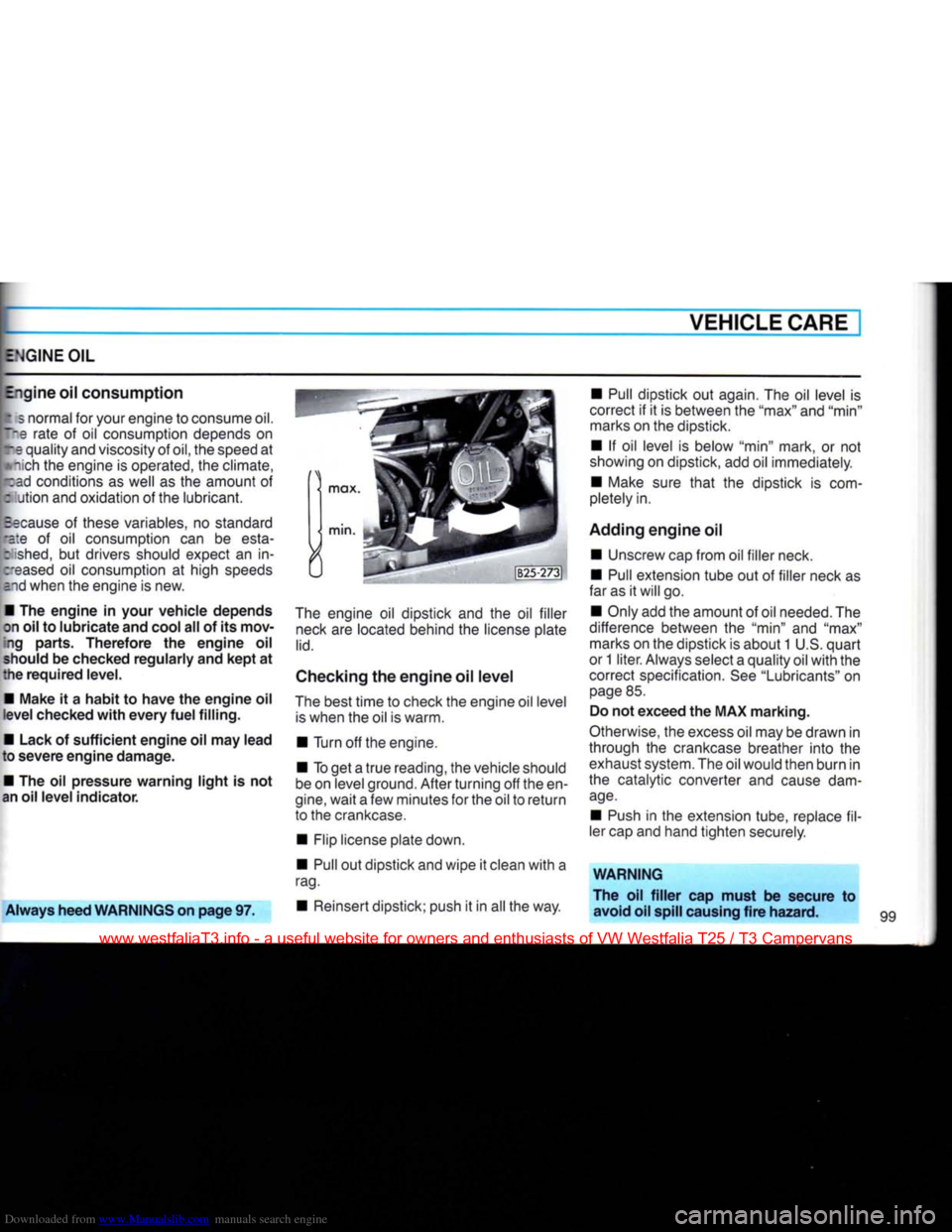
Downloaded from www.Manualslib.com manuals search engine
VEHICLE CARE
ENGINE OIL
Engine oil consumption t 3 normal for your engine to consume oil.
T-Q
rate of oil consumption depends on
re quality and viscosity of
oil,
the speed at
Mich
the engine is operated, the climate,
read
conditions as well as the amount of : ution and oxidation of the lubricant.
Because
of these variables, no standard
•e:e
of oil consumption can be esta-
:
shed,
but drivers should expect an in
creased
oil consumption at high speeds
s.nd when the engine is new.
• The
engine
in your
vehicle
depends
on oil to
lubricate
and cool all of its
mov
ing
parts.
Therefore
the
engine
oil
should be checked
regularly
and
kept
at
the
required
level.
•
Make
it a
habit
to
have
the
engine
oil
level
checked
with
every
fuel
filling.
• Lack of
sufficient
engine
oil may
lead
to
severe
engine
damage.
• The oil pressure
warning
light
is not
an oil
level
indicator.
Always
heed
WARNINGS
on
page
97.
The
engine oil dipstick and the oil filler
neck
are located behind the license plate
lid.
Checking the
engine
oil
level
The
best time to check the engine oil level
is
when the oil is warm.
• Turn off the engine.
• To get a true reading, the vehicle should
be
on level ground. After turning off the en
gine,
wait a few minutes for the oil to return
to the crankcase.
• Flip license plate down.
• Pull out dipstick and wipe it clean
with
a
rag.
• Reinsert dipstick; push it in all the way. • Pull dipstick out again. The oil level is
correct if it is between the "max" and "min" marks on the dipstick.
• If oil level is below "min" mark, or not
showing on dipstick, add oil immediately.
• Make sure
that
the dipstick is com
pletely in.
Adding
engine
oil • Unscrew cap from oil filler neck.
• Pull extension tube out of filler neck as
far as it will go.
• Only add the amount of oil needed. The
difference between the "min" and "max" marks on the dipstick is about
1
U.S. quart
or
1
liter. Always select a quality oil
with
the
correct specification. See "Lubricants" on
page
85.
Do not exceed the MAX
marking.
Otherwise,
the excess oil may be drawn in
through the crankcase breather into the exhaust system. The oil would then burn in
the catalytic converter and cause dam
age.
•
Push
in the extension tube, replace fil
ler cap and hand tighten securely.
WARNING
The oil
filler
cap
must
be secure to avoid oil spill causing
fire
hazard.
www.westfaliaT3.info - a useful website for owners and enthusiasts of VW Westfalia T25 / T3 Campervans
Page 108 of 165
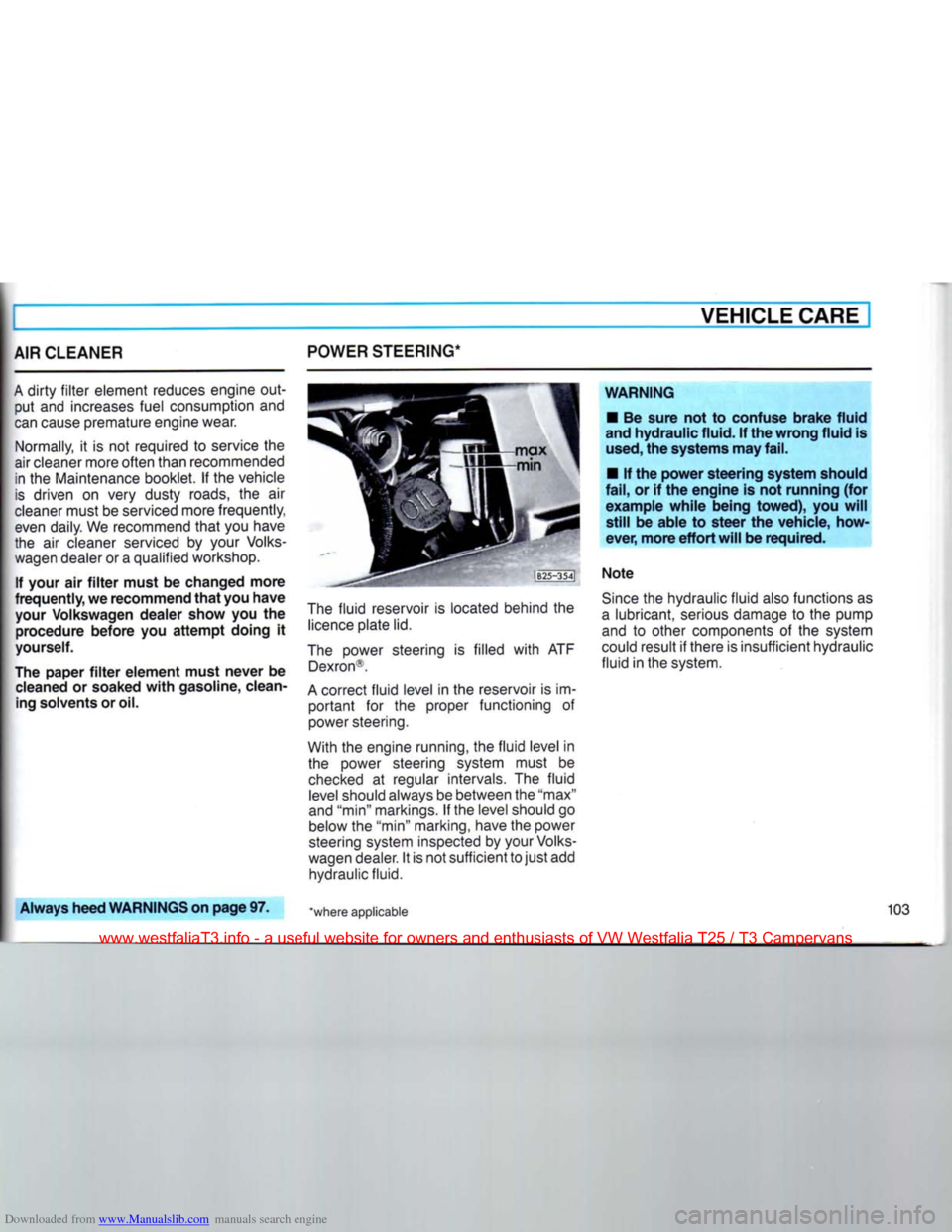
Downloaded from www.Manualslib.com manuals search engine
VEHICLE
CARE
I
AIR CLEANER
A
dirty
filter
element reduces engine
out
put and increases fuel consumption and
can
cause premature engine wear.
Normally, it is not required to service the
air cleaner more often than recommended in the Maintenance booklet. If the vehicle
is
driven on very dusty roads, the air
cleaner
must be serviced more frequently,
even
daily. We recommend
that
you have
the air cleaner serviced by your
Volks
wagen dealer or a qualified workshop.
If
your
air
filter
must
be
changed more
frequently,
we
recommend
that
you have
your
Volkswagen dealer show
you the
procedure
before
you
attempt
doing
it
yourself.
The
paper
filter
element must never
be
cleaned
or
soaked
with
gasoline, clean
ing
solvents or oil. POWER STEERING*
The
fluid
reservoir is located behind the
licence
plate lid.
The
power steering is filled
with
ATF Dexron®.
A
correct
fluid
level in the reservoir is im
portant
for the proper functioning of
power steering.
With the engine running, the
fluid
level in the power steering system must be
checked
at regular intervals. The
fluid
level
should always be between the "max"
and "min" markings. If the level should go below the "min" marking, have the power
steering system inspected by your
Volks
wagen dealer. It is not sufficient to
just
add hydraulic fluid.
WARNING
•
Be
sure
not to
confuse brake fluid
and
hydraulic fluid.
If
the wrong fluid
is
used,
the systems may fail.
•
If the
power steering system should
fail,
or if the
engine
is not
running
(for
example
while
being
towed),
you
will
still
be
able
to
steer
the
vehicle, how
ever, more
effort
will
be required.
Note
Since
the hydraulic
fluid
also functions as
a
lubricant, serious damage to the pump
and to other components of the system
could result if there is insufficient hydraulic
fluid
in the system.
Always
heed WARNINGS on page
97. "where applicable
www.westfaliaT3.info - a useful website for owners and enthusiasts of VW Westfalia T25 / T3 Campervans
Page 121 of 165
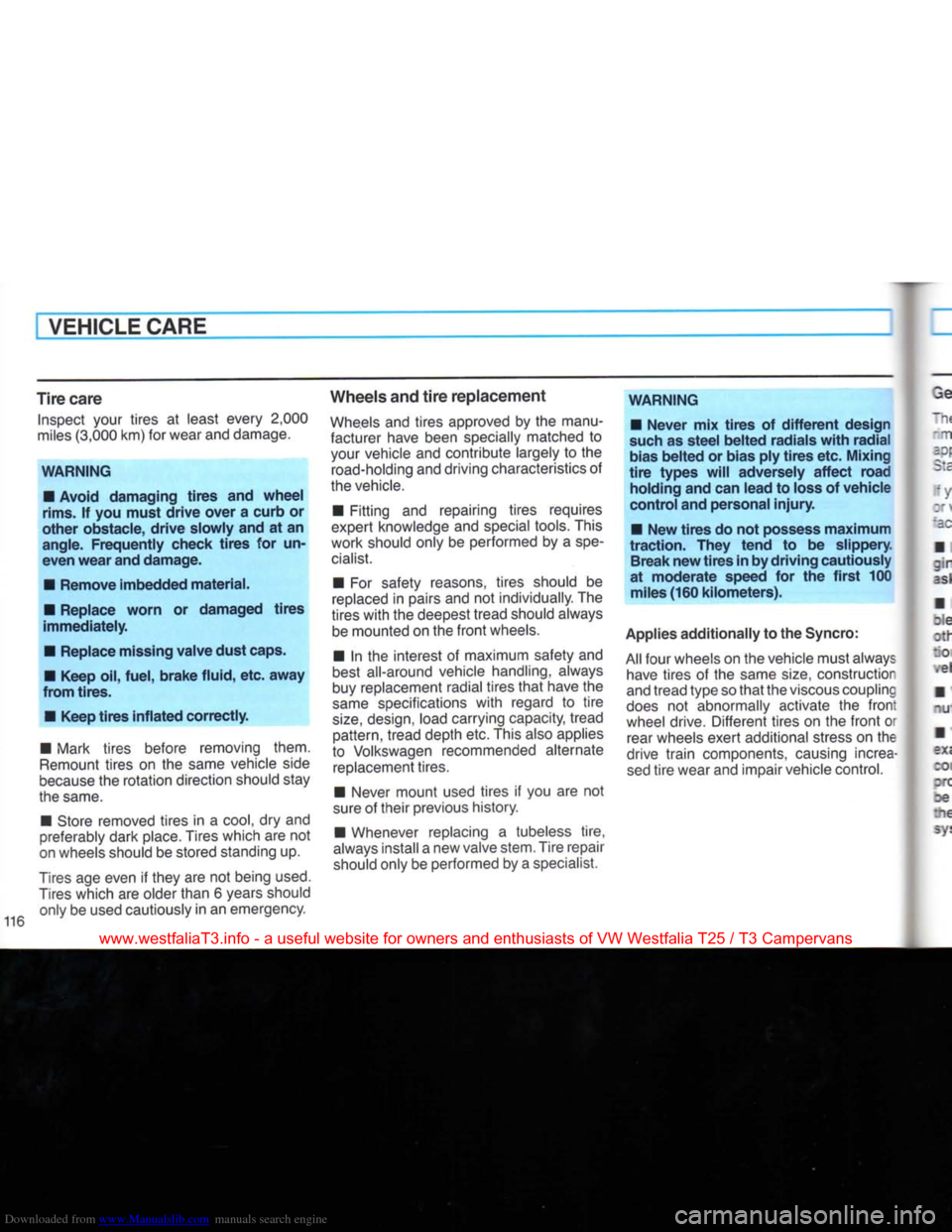
Downloaded from www.Manualslib.com manuals search engine
VEHICLE CARE
Tire
care
Inspect your tires at least every 2,000
miles (3,000 km) for wear and damage.
WARNING
• Avoid
damaging
tires
and
wheel
rims.
If you
must
drive
over
a
curb
or
other
obstacle,
drive
slowly
and at an
angle.
Frequently
check
tires
for un
even
wear
and
damage.
•
Remove
imbedded
material.
•
Replace
worn
or
damaged
tires
immediately.
•
Replace
missing
valve
dust
caps.
• Keep oil,
fuel,
brake
fluid,
etc.
away
from
tires.
• Keep
tires
inflated
correctly.
• Mark tires before removing them.
Remount tires on the same vehicle side
because
the rotation direction should stay
the same.
• Store removed tires in a
cool,
dry and
preferably dark place. Tires which are not
on wheels should be stored standing up.
Tires
age even if they are not being
used.
Tires
which are older than 6 years should only be used cautiously in an emergency.
Wheels
and
tire
replacement
Wheels
and tires approved by the manu
facturer have been specially matched to
your vehicle and contribute largely to the road-holding and driving characteristics of
the vehicle.
• Fitting and repairing tires requires
expert knowledge and special tools. This
work should only be performed by a
spe
cialist.
• For safety reasons, tires should be
replaced
in pairs and not individually. The
tires
with
the deepest tread should always be mounted on the
front
wheels.
• In the interest of maximum safety and
best all-around vehicle handling, always
buy replacement radial tires
that
have the
same
specifications
with
regard to
tire
size,
design, load carrying capacity, tread pattern, tread depth etc. This also applies
to Volkswagen recommended alternate replacement tires.
• Never mount used tires if you are not
sure of their previous history.
• Whenever replacing a tubeless tire,
always install a new valve stem. Tire repair
should only be performed by a specialist.
WARNING
•
Never
mix
tires
of
different
design
such as
steel
belted
radials
with
radial
bias
belted
or
bias
ply
tires
etc.
Mixing
tire
types
will
adversely
affect
road
holding
and can
lead
to loss of
vehicle
control
and
personal
injury.
• New
tires
do not possess
maximum
traction.
They
tend
to be
slippery.
Break
new
tires
in by
driving
cautiously
at
moderate
speed for the
first
100
miles
(160
kilometers).
Applies
additionally
to the Syncro:
All
four wheels on the vehicle must always have tires of the same
size,
construction
and tread type so
that
the viscous coupling
does
not abnormally activate the
front
wheel drive. Different tires on the
front
or rear wheels exert additional stress on the
drive
train
components, causing increa
sed
tire
wear and impair vehicle control.
www.westfaliaT3.info - a useful website for owners and enthusiasts of VW Westfalia T25 / T3 Campervans
Page 125 of 165
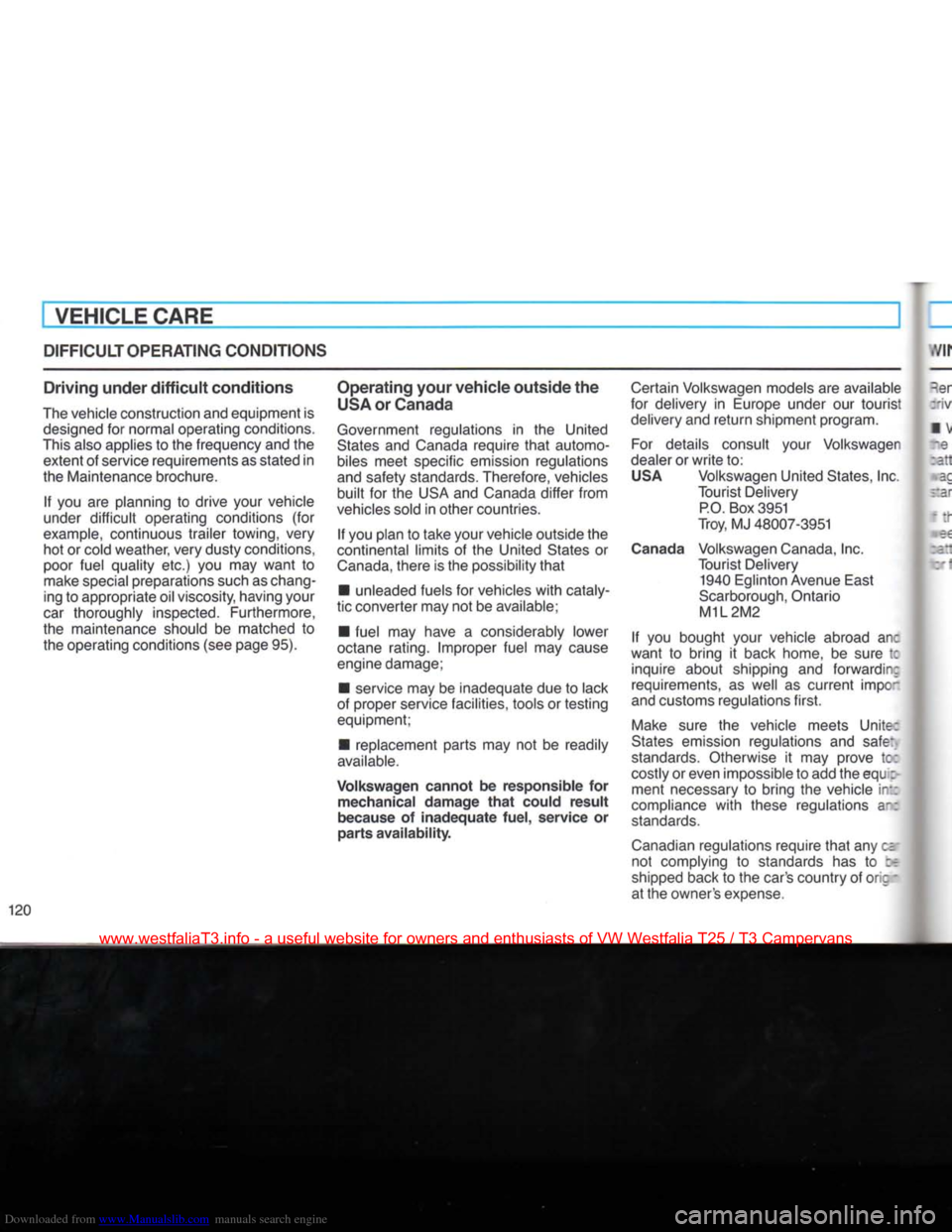
Downloaded from www.Manualslib.com manuals search engine
[VEHICLE
CARE
DIFFICULT
OPERATING
CONDITIONS
Driving
under
difficult
conditions
The
vehicle construction and equipment is
designed
for normal operating conditions.
This
also applies to the frequency and the extent of service requirements as stated in
the Maintenance brochure.
If you are planning to drive your vehicle
under
difficult
operating conditions (for
example,
continuous trailer towing, very hot or cold weather, very dusty conditions,
poor fuel quality etc.) you may
want
to
make
special preparations such as chang
ing to appropriate oil viscosity, having your
car
thoroughly inspected. Furthermore,
the maintenance should be matched to
the operating conditions (see page 95).
Operating
your
vehicle
outside
the
USA
or
Canada
Government
regulations in the United
States
and
Canada
require
that
automo
biles
meet specific emission regulations
and
safety standards. Therefore, vehicles
built
for the USA and
Canada
differ
from
vehicles
sold in other countries.
If you plan to take your vehicle outside the
continental limits of the United States or
Canada,
there is the possibility
that
• unleaded fuels for vehicles
with
cataly
tic converter may not be available;
• fuel may have a considerably lower
octane rating. Improper fuel may cause
engine damage;
• service may be inadequate due to lack
of proper service facilities, tools or testing
equipment;
• replacement parts may not be readily
available.
Volkswagen
cannot be responsible for
mechanical
damage
that
could result
because
of inadequate fuel, service or
parts availability.
Certain
Volkswagen models are available
for delivery in Europe under our
tourist
delivery and
return
shipment program.
For
details consult your Volkswagen
dealer
or
write
to:
USA
Volkswagen United States, Inc. Tourist Delivery
P.O.
Box 3951
Troy, MJ 48007-3951
Canada
Volkswagen
Canada,
Inc. Tourist Delivery 1940 Eglinton Avenue
East
Scarborough,
Ontario
M1L2M2
If you bought your vehicle abroad an:
want
to bring it back home, be sure M inquire about shipping and forwardin:
requirements, as well as current impc
and
customs regulations
first.
Make
sure the vehicle meets Unite:
States
emission regulations and safe:
standards.
Otherwise it may prove tc:
costly
or even impossible to add the eqi : ment necessary to bring the vehicle in::
compliance
with
these regulations a-:
standards.
Canadian
regulations require
that
any c= not complying to standards has to
shipped
back to the car's country of oric -
at the owner's expense.
www.westfaliaT3.info - a useful website for owners and enthusiasts of VW Westfalia T25 / T3 Campervans
Page 145 of 165
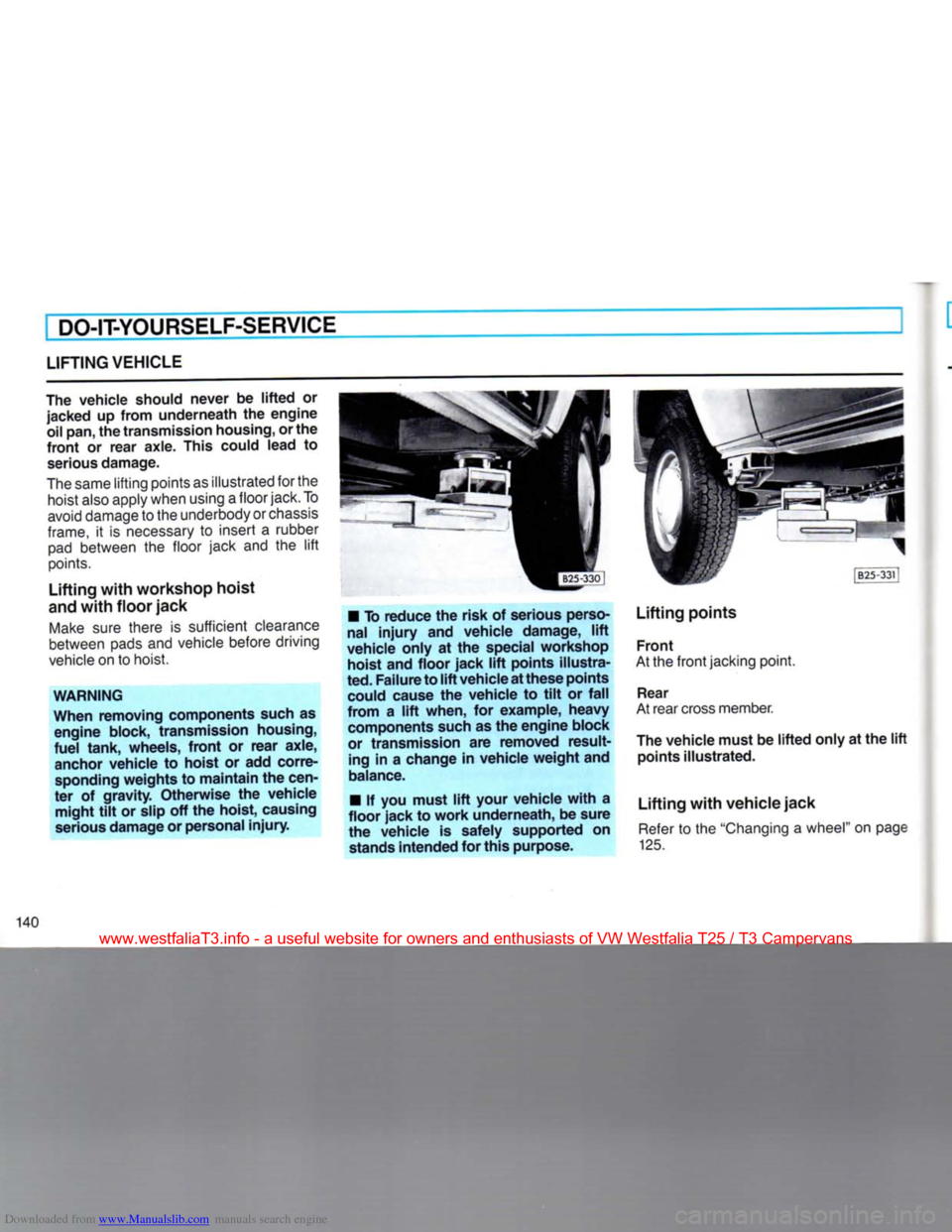
Downloaded from www.Manualslib.com manuals search engine
DO-IT-YOURSELF-SERVICE
LIFTING
VEHICLE
The vehicle should
never
be lifted or
jacked
up from underneath the engine
oil
pan, the transmission housing, or the
front
or rear axle.
This
could lead to serious damage.
The same lifting points as illustrated for the hoist also apply when using a floor jack. To
avoid damage to the underbody or chassis
frame,
it is necessary to insert a rubber pad between the floor jack and the lift
points.
Lifting
with workshop hoist
and with floor jack
Make
sure there is sufficient clearance
between pads and vehicle before driving
vehicle on to hoist.
WARNING
When removing components such as engine block, transmission housing,
fuel
tank, wheels,
front
or rear axle, anchor vehicle to hoist or add corre
sponding weights to maintain the cen
ter of
gravity.
Otherwise the vehicle
might tilt or slip off the hoist, causing
serious damage or personal
injury.
•
To reduce the risk of serious perso
nal
injury
and vehicle damage, lift
vehicle only at the special workshop hoist and floor jack lift points illustra
ted.
Failure to lift vehicle at these points could cause the vehicle to tilt or
fall
from a lift when, for example,
heavy
components such as the engine block
or transmission are removed result
ing
in a change in vehicle weight and
balance.
•
If you must lift
your
vehicle with a
floor jack to work underneath, be sure
the vehicle is safely supported on
stands
intended for this purpose.
Lifting
points
Front
At the
front
jacking point.
Rear
At rear cross member.
The vehicle must be lifted only at the lift
points illustrated.
Lifting
with vehicle jack Refer to the "Changing a wheel" on page
125.
140
www.westfaliaT3.info - a useful website for owners and enthusiasts of VW Westfalia T25 / T3 Campervans
Page 147 of 165
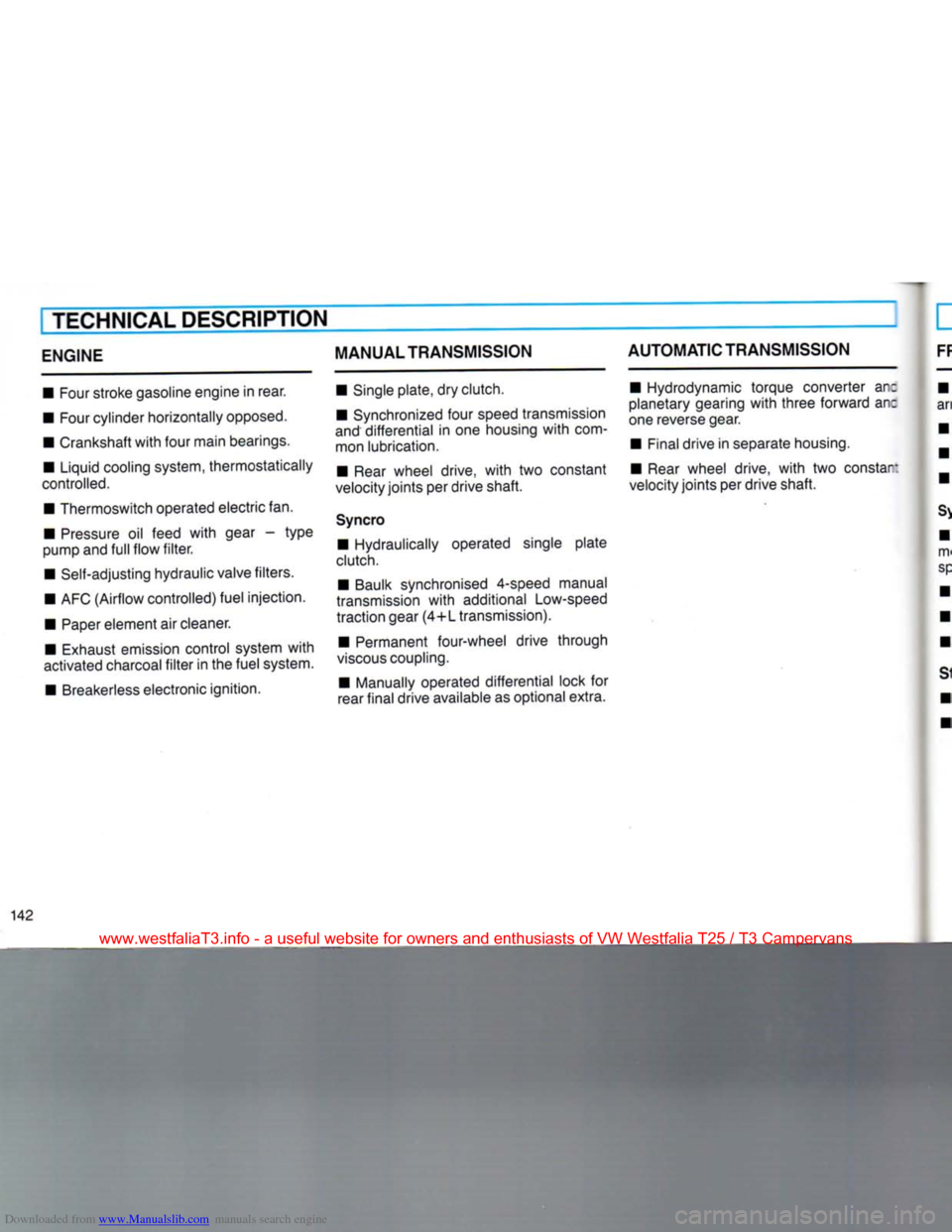
Downloaded from www.Manualslib.com manuals search engine
I TECHNICAL
DESCRIPTION
ENGINE
MANUAL
TRANSMISSION
AUTOMATIC
TRANSMISSION
• Four stroke gasoline engine in rear.
• Four cylinder horizontally opposed.
• Crankshaft
with
four main bearings.
• Liquid cooling system, thermostatically
controlled.
• Thermoswitch operated electric fan. • Pressure oil feed
with
gear - type
pump and
full
flow
filter.
• Self-adjusting hydraulic valve filters.
• AFC (Airflow controlled) fuel injection.
•
Paper
element air cleaner.
• Exhaust emission control system
with
activated charcoal
filter
in the fuel system.
• Breakerless electronic ignition. • Single plate, dry clutch.
• Synchronized four speed transmission
and'
differential in one housing
with
com
mon lubrication.
•
Rear
wheel drive,
with
two constant
velocity joints per drive shaft.
Syncro • Hydraulically operated single plate
clutch.
• Baulk synchronised 4-speed manual
transmission
with
additional Low-speed
traction gear (4+L transmission).
• Permanent four-wheel drive through
viscous
coupling.
• Manually operated differential lock for
rear final drive available as optional extra. • Hydrodynamic torque converter an:
planetary gearing
with
three forward an:
one reverse gear.
• Final drive in separate housing.
•
Rear
wheel drive,
with
two constar:
velocity joints per drive shaft.
www.westfaliaT3.info - a useful website for owners and enthusiasts of VW Westfalia T25 / T3 Campervans
Page 149 of 165
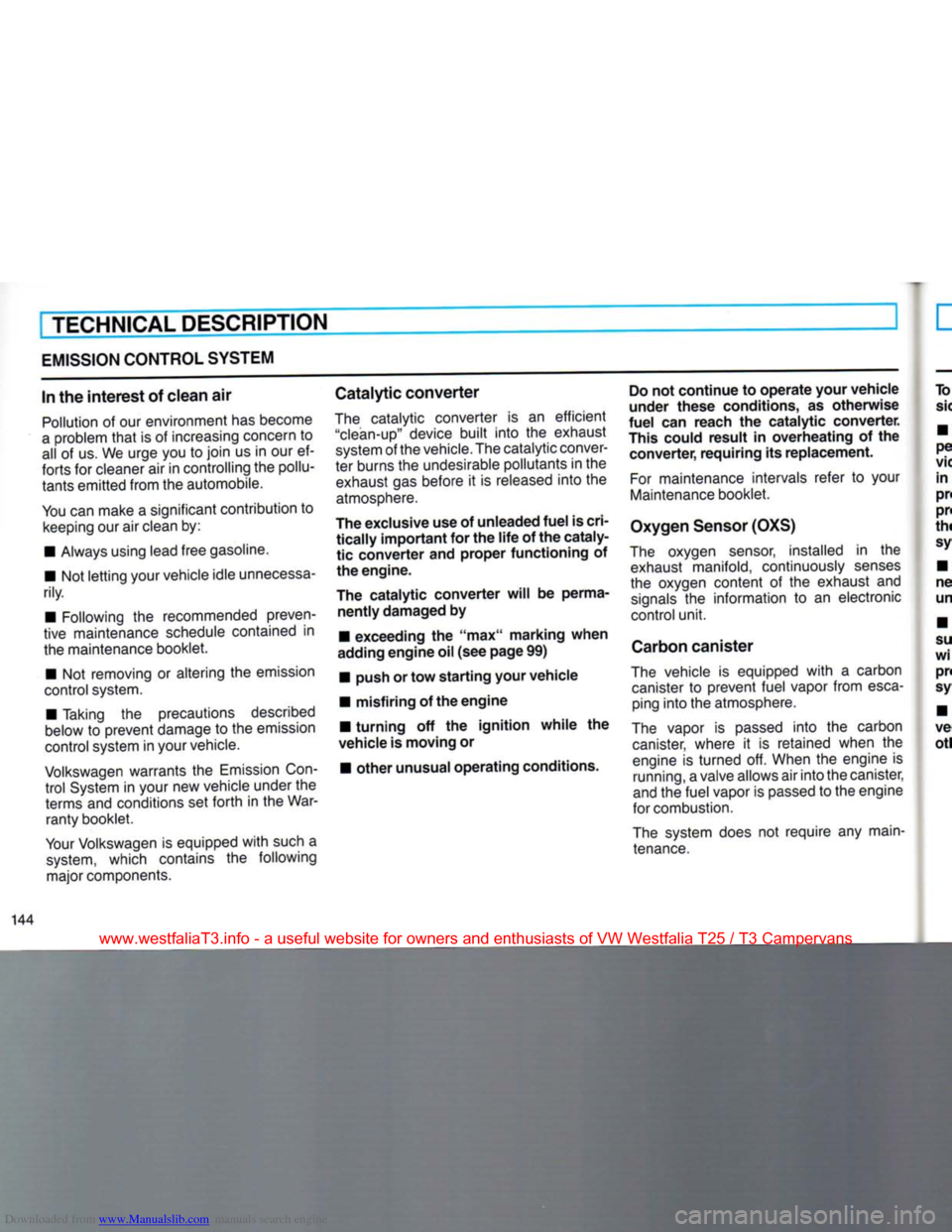
Downloaded from www.Manualslib.com manuals search engine
TECHNICAL
DESCRIPTION
EMISSION
CONTROL SYSTEM
In the
interest
of
clean
air Pollution of our environment has become
a
problem
that
is of increasing concern to
all of us. We urge you to
join
us in our ef
forts
for cleaner air in controlling the pollu
tants emitted from the automobile.
You
can make a significant contribution to
keeping our air clean by:
• Always using lead free gasoline.
• Not
letting
your vehicle idle
unnecessa
rily.
• Following the recommended preven
tive maintenance schedule contained in
the maintenance booklet.
• Not removing or altering the emission
control system.
• Taking the precautions described
below to prevent damage to the emission
control system in your vehicle.
Volkswagen
warrants the Emission
Con
trol
System in your new vehicle under the
terms and conditions set
forth
in the War ranty booklet.
Your
Volkswagen is equipped
with
such a
system,
which contains the following major components.
Catalytic
converter
The catalytic converter is an efficient
"clean-up"
device
built
into
the exhaust system of the vehicle. The catalytic conver
ter burns the undesirable pollutants in the exhaust gas before it is released
into
the
atmosphere.
The
exclusive
use of
unleaded
fuel
is cri
tically
important
for the
life
of the
cataly
tic
converter
and
proper
functioning
of
the
engine.
The
catalytic
converter
will
be
perma
nently
damaged
by
•
exceeding
the "max"
marking
when
adding
engine
oil (see
page
99)
• push or tow
starting
your
vehicle
•
misfiring
of the
engine
•
turning
off the
ignition
while
the
vehicle
is
moving
or
•
other
unusual
operating
conditions. Do not
continue
to
operate
your
vehicle
under
these
conditions, as
otherwise
fuel
can
reach
the
catalytic
converter.
This could
result
in
overheating
of the
converter,
requiring
its
replacement.
For
maintenance intervals refer to your
Maintenance booklet.
Oxygen
Sensor (OXS)
The oxygen sensor, installed in the exhaust manifold, continuously
senses
the oxygen content of the exhaust and
signals
the information to an electronic
control
unit.
Carbon
canister
The vehicle is equipped
with
a carbon canister to prevent fuel vapor from
esca
ping
into
the atmosphere.
The vapor is passed
into
the carbon canister, where it is retained when the
engine is turned off. When the engine is running, a valve allows air
into
the canister,
and the fuel vapor is passed to the engine
for combustion.
The system does not require any main
tenance.
144
www.westfaliaT3.info - a useful website for owners and enthusiasts of VW Westfalia T25 / T3 Campervans
Page 150 of 165
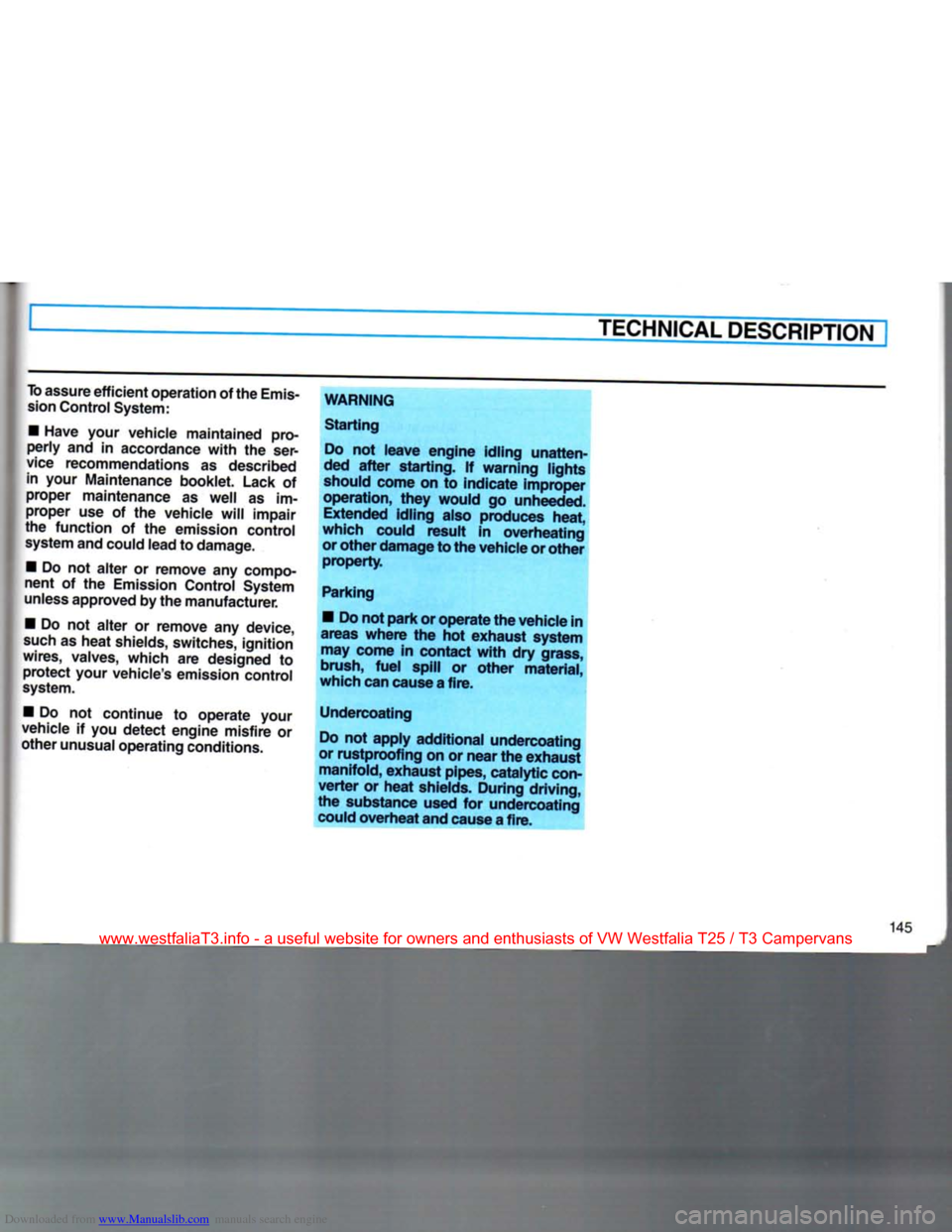
Downloaded from www.Manualslib.com manuals search engine
TECHNICAL
DESCRIPTION
To
assure
efficient
operation
of
the
Emis
sion
Control
System:
•
Have
your
vehicle maintained pro
perly and in accordance
with
the ser
vice recommendations as described in
your
Maintenance booklet. Lack of
proper maintenance as
well
as im
proper use of the vehicle
will
impair
the function of the emission control
system
and
could
lead
to
damage.
•
Do not alter or remove any compo
nent of the Emission Control System
unless
approved
by
the
manufacturer.
•
Do not alter or remove any device,
such
as heat shields, switches, ignition
wires, valves, which are designed to protect
your
vehicle's emission control
system.
•
Do not continue to operate
your
vehicle if you detect engine misfire or
other
unusual
operating conditions. WARNING
Starting
Do
not leave engine idling unatten
ded
after starting. If warning lights should come on to indicate improper
operation,
they would go unheeded. Extended idling also produces heat,
which could result in overheating
or other
damage
to
the
vehicle
or
other
property.
Parking
•
Do
not
park
or
operate
the
vehicle
in
areas
where the hot exhaust system
may
come in contact
with
dry grass,
brush,
fuel spill or other material,
which
can
cause
a
fire.
Undercoating
Do
not apply additional undercoating
or rustproofing on or
near
the
exhaust
manifold,
exhaust
pipes,
catalytic
con
verter
or heat shields. During driving,
the substance used for undercoating
could
overheat
and
cause
a
fire.
www.westfaliaT3.info - a useful website for owners and enthusiasts of VW Westfalia T25 / T3 Campervans